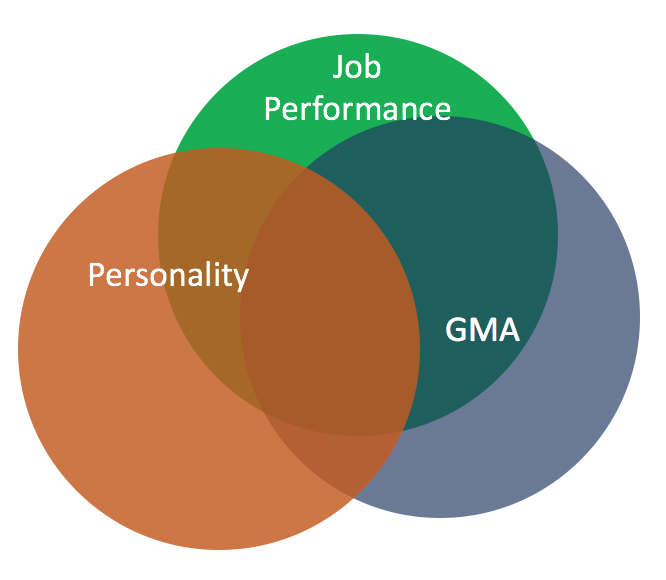Multiple Predictor Combinations in Talent Selection
-

The purpose of a selection system is to identify high performing applicants who would fit well in the organization. Selection systems often include predictor measures that have been quantitatively linked to job performance and other valued aspects to help boost organizational effectiveness. However, even with the strongest predictors of performance, including multiple predictor combinations in a selection system is usually, if not always, better than using a single predictor to select top candidates. The primary reason being that no single selection test is perfect or all-encompassing. Herein, I use general mental ability (GMA) and personality, two commonly used selection assessments, to illustrate the benefits of implementing a multiple predictor combination.
General Mental Ability
One of the best predictors of job performance is GMA, which has been shown to explain up to 31% of the variance in job performance (see figure below for illustration). This means that up to 31% of all potential variation between applicant performance can be predicted by a GMA test. However, there are potential issues involved with relying solely on ability or intelligence tests for employee selection; GMA tests have sometimes produced sub-group differences in ability scores. To address this issue, it is recommended that selection systems that include GMA tests should also include other selection measures with low risk of adverse impact, such as personality tests or working memory, among other reasons.
Personality
Personality tests are highly valued in selection systems because of their ability to predict performance and fit within an organization. Personality tests have been shown to explain a significant amount variance in job performance (see figure below for illustration). Though the predictive validity of personality is sometimes not as high as that of GMA, there are no prominent sub-group differences in scores on personality tests; thus, there is low risk for adverse impact. There are concerns of applicant faking when completing personality assessments, but research has demonstrated that faking is systemic and therefore, faking does not differentially impact scores.
Combining GMA and Personality
As indicated above, both GMA and personality have benefits and risks when being used in selection assessments. However, the combination of the two predictors creates a better, more valid, selection system than either predictor alone (see figure below for illustration).Research has consistently found GMA to be the strongest predictor of job performance; nonetheless, personality constructs such as conscientiousness and honesty-humility have been found to predict performance over and beyond GMA alone.The combination of GMA and conscientiousness tests have been shown to explain the majority of variance in job performance, meaning more than half of job performance can be explained by a combination of just two different predictor tests. Moreover, in some situations, predictor combinations of ability and conscientiousness can reduce the participant faking concern related to personality assessments (Peterson, Griffith, & Converse, 2009). Thus, combining personality with other predictors can not only improve predictive validity, it can even reduce the issues within personality testing.
How Many Predictors to Add?
It seems from the logic above that the more predictors will always yield better prediction. Well, there is a limit to this. The illustration below provides an example of what it looks like to have too many predictors. Notice how predictor X overlaps with the other predictors but does not offer much unique overlap with performance.
Moreover, in some situations, predictor combinations of ability and conscientiousness can reduce the participant faking concern related to personality assessments (Peterson, Griffith, & Converse, 2009). Thus, combining personality with other predictors can not only improve predictive validity, it can even reduce the issues within personality testing.
How Many Predictors to Add?
It seems from the logic above that the more predictors will always yield better prediction. Well, there is a limit to this. The illustration below provides an example of what it looks like to have too many predictors. Notice how predictor X overlaps with the other predictors but does not offer much unique overlap with performance.
 Predictors that are unrelated to the outcome of interest or predictors that are too related to each other will not improve prediction. In fact, including too many similar predictors can lead to inaccurate prediction and make it difficult to identify which predictors are driving the results. Thus, all predictors included in a selection system should: 1) be backed by a theoretical relationship between the predictor and the outcome, and 2) capture unique variance in the outcome that is not already captured by other predictors.
Conclusion
Multiple predictor combinations are frequently used in selection systems because of the benefits discussed above. GMA and personality are only one of the commonly used combinations in selection assessments. Other selection methods such as interviews and work samples can also benefit from being combined with other predictors in a selection system. In summary, combining multiple predictors can increase the predictive validity of the selection system, reduce the issues posed by any single predictor alone, and thus, can improve the bottom line of an organization.
Predictors that are unrelated to the outcome of interest or predictors that are too related to each other will not improve prediction. In fact, including too many similar predictors can lead to inaccurate prediction and make it difficult to identify which predictors are driving the results. Thus, all predictors included in a selection system should: 1) be backed by a theoretical relationship between the predictor and the outcome, and 2) capture unique variance in the outcome that is not already captured by other predictors.
Conclusion
Multiple predictor combinations are frequently used in selection systems because of the benefits discussed above. GMA and personality are only one of the commonly used combinations in selection assessments. Other selection methods such as interviews and work samples can also benefit from being combined with other predictors in a selection system. In summary, combining multiple predictors can increase the predictive validity of the selection system, reduce the issues posed by any single predictor alone, and thus, can improve the bottom line of an organization.